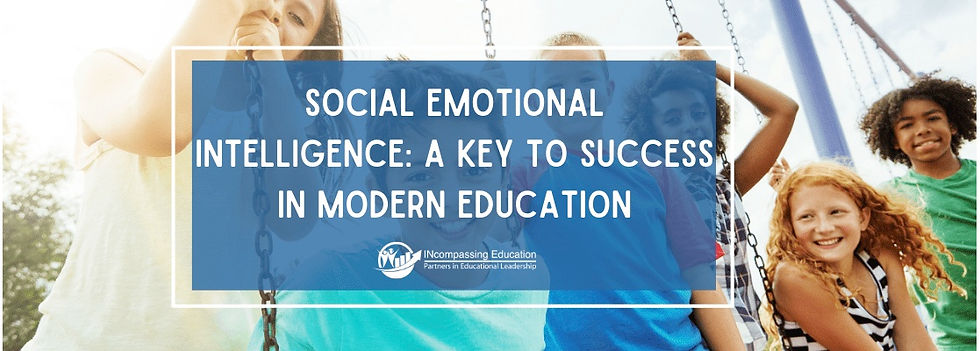Social Emotional Intelligence: A Key to Success in Modern Education
- Dianne McKinley
- Sep 17, 2023
- 5 min read
Updated: Dec 16, 2025

Social emotional intelligence is a crucial aspect of modern education that has gained increasing attention in recent years. Social emotional intelligence (SEI) refers to the ability to identify, understand, and manage one’s own emotions, as well as the emotions of others. It involves developing empathy, building meaningful relationships, and effectively communicating with others.
Having social emotional intelligence can significantly impact academic performance and overall success in life. Students who possess this skill set are better equipped to handle stress, solve problems collaboratively, and establish positive relationships with their peers. They also tend to have higher levels of motivation and engagement in school. Educators have recognized the importance of teaching social emotional skills alongside traditional academic subjects. Many schools have implemented programs designed to promote social emotional learning through activities such as group discussions about feelings and problem-solving scenarios.

The Importance of Social Emotional Intelligence in Education

In the educational setting, developing SEI can have a positive impact on students’ academic performance, behavior, and their capacity to build meaningful relationships with their peers. SEI can help students develop self-discipline, resilience, and empathy. It can also help them become more aware of their own emotions and those of others, leading to improved communication and collaboration.
Unfortunately, SEI is often overlooked in traditional educational settings. This is a mistake since SEI is necessary for success in the real world. It is important for educators to create an environment where students feel safe and supported so that they can develop their social emotional skills. This can be done in various ways, such as through the use of positive reinforcement, class discussions, and activities that focus on understanding and expressing emotions in healthy ways.
In addition to creating a supportive environment, educators should also include SEI-related topics in their curriculums. This could include teaching students how to regulate their emotions, how to handle difficult conversations, how to establish and maintain healthy relationships, and how to resolve conflicts. By incorporating these topics into their curriculums, educators can ensure that their students are well-equipped to navigate the emotional and social realities of adulthood. SEI is an essential skill for success in education and beyond. Educators need to recognize its importance and create an environment wherein students can develop their social emotional skills. By doing so, they can ensure that their students have the tools they need to thrive in school and in life.
Benefits of Developing Social Emotional Intelligence in Students
Individuals with strong social emotional intelligence are better equipped to cope with stress and anxiety. They possess a heightened sense of self-awareness, allowing them to identify their triggers and take proactive steps towards managing their emotions. This skill can significantly reduce instances of academic burnout and improve overall academic performance. Developing social emotional intelligence helps students build stronger relationships with peers and teachers. Individuals who possess this trait are better at communication, active listening, empathy, conflict resolution and collaboration. These skills not only foster positive relationships but also enhance teamwork abilities – a crucial aspect in today’s workplace.
How to Incorporate Social Emotional Learning Into the Classroom
Social emotional learning (SEL) involves teaching students the essential skills of recognizing and regulating their own emotions, establishing and attaining constructive objectives, cultivating empathy towards others, fostering and sustaining positive relationships, and making conscientious choices.

You can incorporate social emotional learning by:
Creating an atmosphere of acceptance and understanding in the classroom is essential for social emotional learning to take place. Foster an inclusive and inviting atmosphere for every student, where they feel comfortable expressing their emotions openly, without any apprehension of judgment or criticism.
Including social activities such as role-playing, cooperative learning activities, journaling, and problem-solving games.
Reflection is an important part of social emotional learning. Give students regular opportunities to reflect on their experiences, both positive and negative, in order to better understand the impact of their emotions and actions on themselves and others.
As a teacher, you serve as a role model for your students. Make sure you are modeling appropriate behaviors and language. This will help to reinforce the importance of SEL in the classroom.
Keep track of your students’ progress in social emotional learning. This can be done through checklists, surveys, and other assessment tools. This will help you to tailor your instruction and ensure that your students are making progress.
Examples of Schools Implementing Social Emotional Learning Programs

Social emotional intelligence is a crucial aspect of modern education, with multiple studies suggesting that students who possess strong social emotional skills achieve better academic outcomes. These skills enable individuals to manage their emotions and interact positively with others, leading to improved self-awareness, self-management, motivation, empathy and social awareness. As such, schools across the United States have been implementing various initiatives aimed at developing the social emotional intelligence of their students.
For instance, several schools have adopted programs that focus on mindfulness practices like deep breathing exercises and meditation techniques. Such efforts help students develop self-regulation skills by promoting calmness and reducing stress levels. Additionally, some schools have incorporated community service activities into their curriculum which encourage empathy and civic engagement among students. This provides an opportunity for learners to apply their social emotional skills in real-life scenarios while giving back to society.
Challenges and Solutions for Incorporating SEL into Education

Today’s students face a variety of challenges that can impact their academic performance, including mental health issues, social pressures, and the fast-paced and often stressful nature of contemporary culture.
To address these challenges and promote student success, many educators are turning to SEL programs. These programs aim to help students develop skills such as self-awareness, self-regulation, empathy, and relationship-building – all vital components of emotional intelligence.
Here are some challenges and solutions for incorporating SEL into modern education:
Time constraints: Educators often struggle to find enough time to incorporate SEL into their busy schedules. One solution is to integrate SEL lessons into existing subjects such as English or social studies.
Lack of resources: Many schools don’t have the necessary resources or materials needed to teach SEL effectively. A solution is to seek out free online resources or partner with organizations that provide curriculum and training support.
Resistance from teachers: Some teachers may resist teaching SEL, believing it’s not their responsibility or that it takes away from academic learning time.
Conclusion
A crucial aspect of promoting social-emotional learning (SEL) throughout the entire school involves its integration into multi-tiered systems of support. The assistance offered to students by professionals like education consultants, counselors, social workers, and psychologists should align with the overall efforts taking place in classrooms and within the school building. Through activities such as small-group sessions, these support personnel can strengthen and complement the instruction provided in the classroom, particularly for students requiring early intervention or more intensive treatment.
INcompassing Education provides on-site, off-site, and online professional development for teachers. Contact us to learn more.





